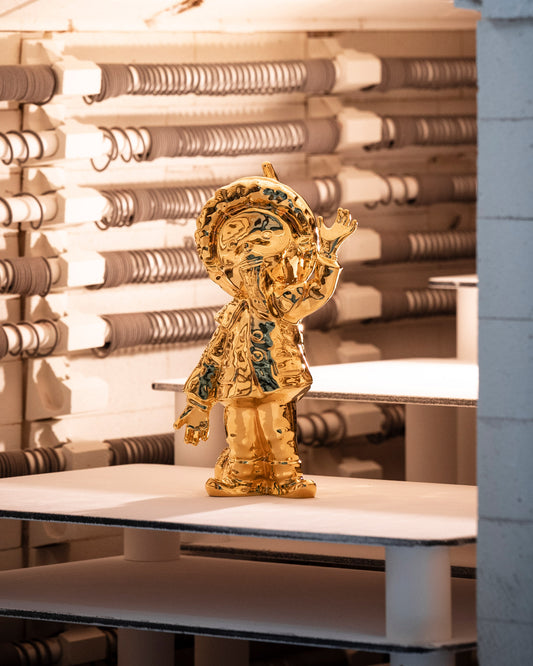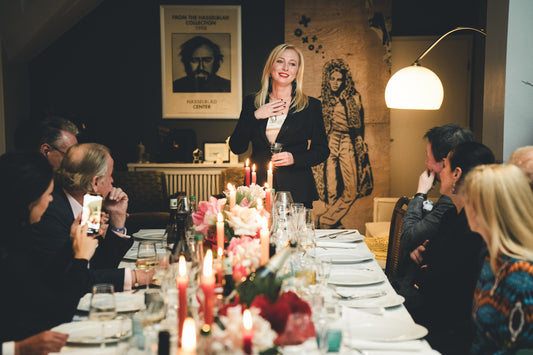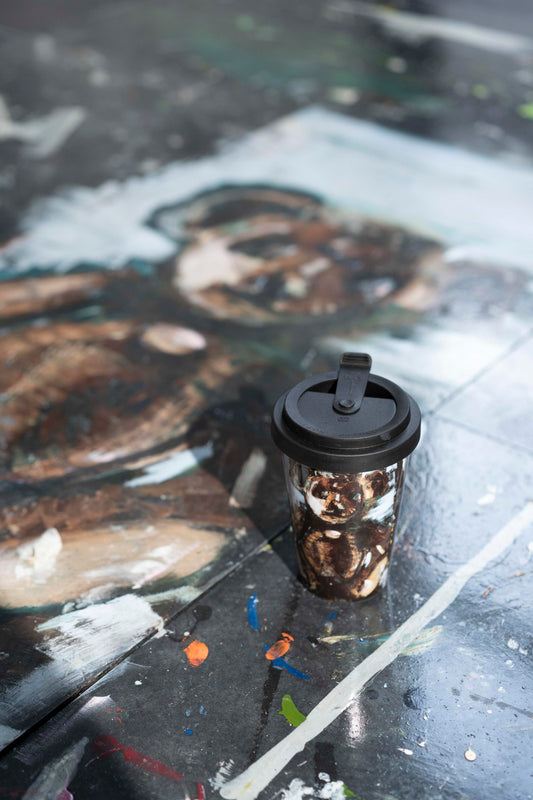SIEGMUND SCHÜTZ AND THE GRACIAL MEDALLIONS OF THE KPM ARKADIA COLLECTION
The KPM ARKADIA collection doesn't just decorate your table. Thanks to Siegmund Schütz's medallions, it also takes you into the fantastic world of ancient myths and stimulates exciting conversations. Discover these little gems!
In the early 1930s, the sculptor Siegmund Schütz created a series of delicate relief medallions for KPM Berlin, which were originally intended as independent jewelry cameos. Building on these medallions, Trude Petri designed a matching service form in 1938 - on the occasion of the 175th anniversary of the KPM - the ARKADIA tea service.
On the front sides of the shiny glazed vessels and plate flags, relief medallions made of unglazed porcelain, so-called bisque porcelain, were implemented. With the six place settings with different biscuit medallions, the main motif of the plate is varied on the lower bowl. Thematically, the small medallions are linked to the ancient gemstone tradition. They tell stories from the dreamland of Arcadia, which the Roman poet Virgil made the setting for his works. To this day they shape the idealized image of pastoral life in Arcadia and Greece. Let's take a closer look at the fragile relief medallions and their ancient motifs:
Ceres and the ears of corn
The ARKADIA dessert plate with a diameter of 210 mm shows Ceres, the daughter of Saturn and Ops, as one of six relief medallions. She is the Roman goddess of agriculture and fertility. Her Greek name is Demeter, daughter of the Titan leader Kronos and the goddess of the cornfields, Rhea. She is often shown with fruit and a torch, cornucopia and ears of corn and embodies summer. Before sowing and after spring sowing was completed, women made a public sacrifice to her. On the medallion, Ceres divides it into a sunny half and a rainy half, in which she is holding a seedling in her hand.
The ARKADIA tea base bowl with a diameter of 170 mm shows the ears of grain, the attribute of the mother goddess Demeter, as one of six relief medallions. As one of the twelve Olympian deities, she is responsible for the fertility of the earth, grain and seeds. Her Roman god's name is Ceres. The ears of corn symbolize life and the abundance of undeveloped possibilities. The oldest wheat finds date back to around 7800 BC. BC, making wheat the second oldest grain after barley.
The hunting Diana and the moon
The medallion of the ARKADIA salad bowl (200 mm diameter) made of the finest bisque porcelain shows Diana, the Roman goddess of the hunt and the moon, protector of women and girls. She corresponds to Artemis in Greek mythology. She is often depicted as a young hunter with a short chiton, a quiver with a bow and arrows and a young deer or dog as a companion.
Diana is the daughter of Zeus and Leto and is one of the twelve great Olympian gods, making her one of the most important deities in Greek mythology. Diana is depicted on the medallion hunting at night with a dog and a spear in her hand.
The oval cream jug with a capacity of 0.12 liters from the Amor mocha service shows the moon goddess Selene and a crescent moon, a widely used symbol of ancient mythology, on its relief medallion. The personified moon in the form of Selene embodies the female principle and, due to its changing shape, is equated with the growth and decay on earth.
The moon is also considered one of the fertility symbols. Together with her two siblings Eos, goddess of the dawn and Helios, the sun god, she changes day and night every day. On the delicate medallion, Selene appears in profile with her hair down in a crescent moon.
Animal companions
The ARKADIA tea saucer shows two fish as a motif on its relief medallion. The fish are associated with the water god Neptune and the element water and are considered a symbol of life, but also of death. Hesiod tells how Aphrodite, goddess of love, was playing with her little son Eros on the banks of the Euphrates when the huge monster Typhon appeared to destroy them both. She was saved because the nymph of the river sent the desperate goddess two large, gentle fish with a string tied to their tails. As a thank you for the rescue, both fish were then placed in the sky as a constellation.
Another relief medallion of the ARKADIA tea saucer shows a dolphin, which appears in Greek mythology as an animal of the goddess Demeter but also of the sea god Poseidon Hippios. He was considered godlike by the Greeks and Romans. When the sun god Apollo was born on an island in the middle of the sea, he was brought ashore by a dolphin. He was also elevated to heaven as a constellation because he helped Poseidon win the hand of the sea nymph Amphitrite.
Cupid and Putto awaken love
The round sugar bowl from the ARKADIA collection shows the god and the personification of love on its relief medallion in delicate bisque porcelain: Cupid with a bow. The son of Venus and Mars is usually depicted as an adolescent boy who accurately hits the heart with his arrows and thereby awakens love.
Nobody can resist the power of Cupid, because: Omnia vincit Amor! (“Cupid conquers all!”). His Greek name is Eros. In art we often encounter it in the form of so-called cupids, multiple depictions of childish love gods as naked, winged boys.
The elegant ARKADIA milk jug with a capacity of 0.14 liters shows a putto kicking grapes on its biscuit medallion. The boy figure is also a trivialized representation of the Greco-Roman god of love Cupid and is often portrayed as playful and carefree. In ancient mythology, wine symbolizes religious worship and culture.
The Rod of Thyrsus
A tea saucer variant from the ARKADIA collection shows an antique thyrsus staff, actually called thyrsos or Bacchus staff, on its medallion. In Greco-Roman art, the thyrsos appears as an attribute of the maenads, occasionally also of the satyrs and Silenus, of the god Dionysus himself or of his wife Ariadne. Originally Thyrsos is said to have been a staff made from a stalk of giant fennel, but later it is usually depicted as a branch or stick with bandages, vine leaves and ivy.
Nereids, the nymphs of the sea
The elegant ARKADIA gourmet plate is adorned with the medallion of a young Nereid, the nymph of the sea. These 50 daughters of the sea god Nereus and the titan Doris are the faithful companions of the god Poseidon. According to ancient mythology, they live in caves at the bottom of the sea, protect shipwrecked sailors and sailors and entertain them with games.
In many depictions the Nereids ride exuberantly on the backs of dolphins or hippocampuses. The most famous Nereids are the beautifully curly and noble Calypso, who loves the shipwrecked Odysseus and holds him for seven years, and Galathea.
The beautiful Galathea appears on the relief medallion of the coffee pot from the ARKADIA collection. She is carried across the water by her lover, the Cyclops Polyphemus. This love story between the beautiful Nereid and Polyphemus, the frightening figure of the wilderness who tries to civilize herself out of love for Galathea, forms a primeval template for the well-known folk tale “Beauty and the Beast”.
A shell forms a delicate relief medallion on the ARKADIA tea base. As an animal living in the sea, it is often the attribute of sea deities and nymphs. Here the shell is assigned as a symbol to the Nereids. In ancient times, people were convinced that the shell was a genderless creature that emerged from the sea foam, similar to the Greek goddess of love and beauty, Aphrodite.
Aphrodite is often depicted as “the one rising from the sea” standing on a shell. The Greek goddess of the sea, Doris, rides on a shell chariot, accompanied by her daughters, the Nereids, who swim around her.
Diomedes and Pegasus **, the fabulous steeds**
The relief medallion of the bread plate and coffee cup from the ARKADIA collection shows the wild horse of Diomedes, one of the main fighters of the Trojan War and King of Argos. His four wild mares went down in Greek mythology as the horse beasts. According to Greek mythology, Heracles' eighth task was to bring these horses to his cousin Eurystheus. According to Diodorus, he succeeded in this heroic deed by feeding them Diomedes himself and was thus able to lead them towards the sea.
With a diameter of 32 cm, the generous ARKADIA charger plate offers plenty of space for exquisite dishes. His bisque porcelain medallion depicts Pegasus, the winged horse of Greek mythology and a child of the sea god Poseidon and the Gorgon Medusa. A flying hybrid of horse and bird, it carried the hero Bellerophon in the fight against the Chimera and the Amazons. Zeus turned Pegasus into a constellation. In a figurative sense, the winged Pegasus still lives today as a symbol of poetry.
Pan, his flute and the syrinx
The coffee saucer from the ARKADIA collection shows Pan, the shepherd god of Greek mythology, on its medallion. This hybrid creature of man and ram was considered the god of the forest and nature. Pan is usually depicted with a curved shepherd's crook or a seven-tube flute, the pan flute in his hand. In ancient times, the curved shepherd's crook symbolized the nature of things themselves and their cycle. According to mythology, Pan was a son of Hermes and Dryope, who was so frightened at the sight of him that she fled from him.
The elegant dinner plate gives the table a stylish ambience and offers plenty of conversation starters: its relief medallion shows Syrinx, a nymph from Greek mythology. In Ovid's Metamorphoses she spurns the love of the shepherd god Pan. While wildly fleeing from him, she is turned into reeds by the Ladon River at her request. As the desperate god's breath passes through the reeds, a poignant sound is created, whereupon Pan cuts the reeds and makes a flute as a reminder of his love.
The ARKADIA tea saucer with a diameter of 17 cm also shows a pan flute on its medallion. Pan invented this shepherd's flute, which he named after the nymph Syrinx and on which he played his songs from then on. He also competed against Apollo in the music competition with the pan flute: Pan prides himself on making music more beautifully than the god of the arts. However, when he performs his audition on the kithara in an artist's pose with blonde curls, a purple robe and a laurel wreath, he wins the competition.
Discover more pieces from the ARKADIA collection in our online shop and explore the ancient world of legends.


